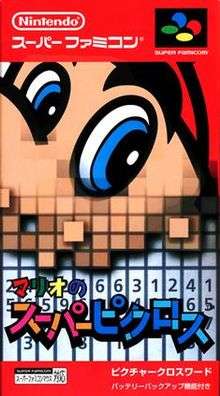Mario's Super Picross
| Mario's Super Picross | |
|---|---|
 Cover art | |
| Developer(s) |
Ape Jupiter |
| Publisher(s) | Nintendo |
| Director(s) | Tsunekazu Ishihara |
| Producer(s) |
Takeshi Kawaguchi Makoto Nakayama |
| Designer(s) |
Agura Tanaka Yasuyuki Yamashita Mituo Fujiwara Akiko Uni Kyoko Tanabe Jun Nakajima |
| Programmer(s) |
Noriaki Teramoto Hatao Ogata |
| Composer(s) | Toshiyuki Ueno |
| Platform(s) | Super Famicom |
| Release |
|
| Genre(s) | Puzzle |
| Mode(s) | Single player |
Mario's Super Picross (マリオのスーパーピクロス Mario no Sūpā Pikurosu) is a Super Famicom sequel to Mario's Picross. It is erroneously named as Mario's Picross 2, which is actually the name of the Game Boy sequel to Mario's Picross. The game is compatible with the Super Famicom Mouse.
After the failure of Mario's Picross in North America, Nintendo decided not to release this game in that region. The game was made available for download on the Wii's Virtual Console service on December 19, 2006 in Japan and later in PAL regions on September 14, 2007, the 12th anniversary of the game's original Japanese release - marking the first Western release of the game, which has been left nontranslated with original Japanese text intact.[1] This game was re-released for download on the Wii U's Virtual Console service in both Japan and the PAL regions on April 27, 2013.
Gameplay
Gameplay remains the same as in Mario's Picross, where the player must decipher the picture in each level, progressing to harder and harder puzzles. However, the player may also play "as" Wario, who presents a different challenge due to changes in the gameplay.
Each game is played against the clock. Opposing the picross tradition of black and white squares, the puzzles are set in stone and are picked out by Mario with a Hammer and Chisel. The initial levels are smaller and a lot easier and are mainly Japanese symbols and Greek letters. When the player solves a puzzle correctly, the black-and-white representation becomes colored and animated, and the game shows the player the title of the puzzle. When the player finishes a level, Mario will congratulate them on their progress and either bow (in the first and last levels) or give a thumbs up (in all other levels).
The player must work through levels in order to get access to harder levels, with more rows and columns. In Mario's puzzles, if the player marks the wrong cell, they get a time penalty. The amount of time lost doubles for every mistake (one minute, two minutes, four, and finally eight). In Wario's puzzles, the time counts up from zero, and the player is not penalized for marking the incorrect cell. However, the player will not be notified if they make a mistake.
References
External links
- Official website(in Japanese)
- Official Jupiter website (in Japanese)
- Official Nintendo Wii eshop Minishop (in Japanese)
- Official Nintendo Wii U eshop Minishop (in Japanese)
- Mario's Super Picross at MobyGames